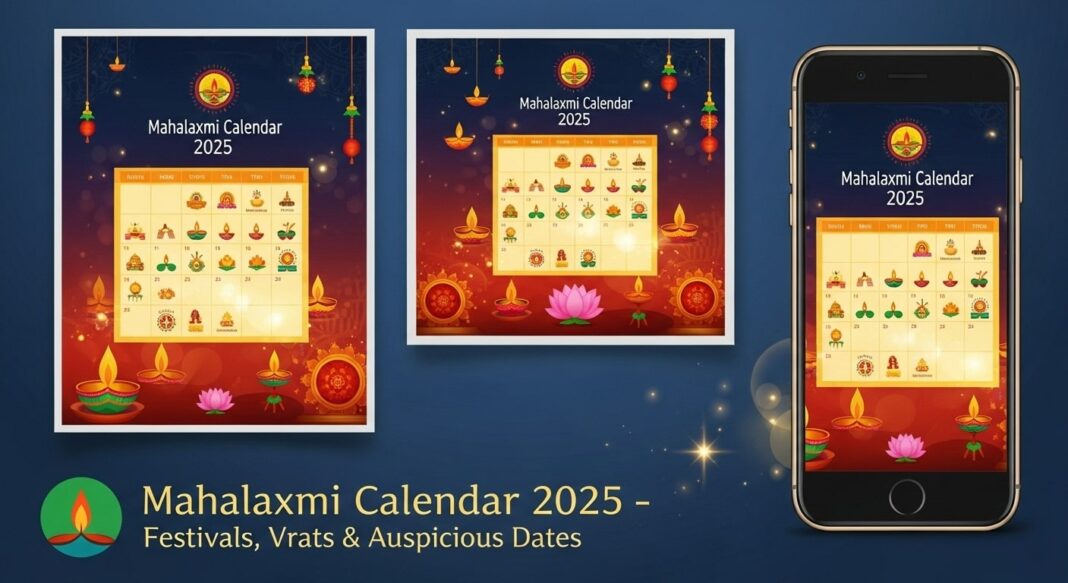In the year 2025, it is likely that you will use Google Calendar for meetings, Slack for communication, and a fitness tracker to achieve your health and fitness goals. So, my question to you is, in this hyper-modern, algorithm-driven world, why do millions still rely on a printed calendar, such as the Mahalaxmi Calendar 2025, which apparently sources its wisdom from the stars?
For over a decade, I have used the Mahalaxmi Calendar—not just as a religious guide—but as a strategic planning tool. This is the gold standard for many families across Maharashtra and beyond. To be honest, I would say that the generic online lists of dates almost do not even scratch the surface of the calendar’s real value.
Many people think of the Mahalaxmi like an old-fashioned artifact—something that, when looked at, reminds you to think about Diwali and an Ekadashi fast. But here’s the truth: the 2025 Mahalaxmi Calendar will serve the modern professional, entrepreneur, and/or student as an evidence-based, reliable, improved framework to harness efficiency, expend emotional energy wisely, and purposely time major life decisions.
What if I told you that the calendar provided unique keys to time your next major career pivot, or your subsequent investment decisions?
What is the Mahalaxmi Calendar 2025, and Why Does it Sustain?
For countless Marathi families, it is not merely a calendar, it is a family tradition — the Mahalaxmi Dinadarshika, or Mahalaxmi Panchang. It will show you:
- The daily kaal, tithi, and nakshatra.
- Auspicious and inauspicious muhurats.
- A list of festivals and vrata (fast) observances.
- Local jatras, fairs, and temple happenings.
- Eclipses, planetary movements, and seasonal changes.
This calendar has been printed for more than 80 years, and it is one of the most trusted panchangs in Maharashtra. In 2025, it will be available in a number of editions: the wall, pocket, express, Marathi, Hindi, and English editions.
The Marathi edition is extremely popular because it provides the most detail on daily events. Many families find it commonplace to hang it in their living room or their kitchen, marking the events through the months.
The Mahalaxmi calendar is not just a device; it represents a cultural system — a tether to our past, to the sky, and to our day-to-day existence.
Key Vrats, Festivals, and Auspicious Observances in 2025
| Date/Month | Vrat/Event | Category/Notes |
| 7 Jan 2025 (Tue) | Banada Ashtami | Vrat/Observance |
| 10 Jan (Friday) | Pausha Putrada Ekadashi | Ekadashi/Vrat |
| 13 Jan | Shakambari Purnima, Pausha Purnima | Festival/holy day |
| 17 Jan | Sakata Chauth | Vrat |
| 25 Jan | Shattila Ekadashi | Ekadashi |
| 29 Jan | Mauni Amavasya | Ancestor rites/Amavasya |
| August (Several dates) | Pola, Krishna Janmashtami, Raksha Bandhan | Major festivals |
| Bhadrapada (post-Ganesh Chaturthi) | Mahalakshmi Vrat (16 days) | Vrat for prosperity |
| October | Navratri, Kojagiri Purnima, Dussehra | Major Hindu festivals |
| November | Diwali, Bhai Dooj, Kartik Purnima | Auspicious period |
| Dec | Margashirsha Guruvaar Vrat | Devotional Observance |
A Closer Look at Important Observances
- Mahalakshmi Vrat: Respected for 16 days from Shukla Ashtami, this happens a few days after Ganesha Chaturthi. This is primarily a devotion-oriented vrat made for Goddess Lakshmi regarding wealth and well-being.
- Mauni Amavasya: Known to be on 29 January 2025, this observance is focused on silence and contemplation and incorporates ancestor worship and purification.
Emerging Trends in 2025
The Mahalaxmi Calendar 2025 comes with interesting cultural and behavioral trends of how people observe festivals today, we see.
Trend 1: Increasing Popularity of Shorter Vratas
When festivals like Navratri and Mahalaxmi Vrat remain front and center, as seen from within the 2025 listings, a boost in one-day vratas and shorter pujas is also seen. Urban devotees, away from their communities, continue to practice traditions accordingly and seem more inclined to practice shorter vratas over longer engagements.
Trend 2: Monsoon Festival Grouping
July-September has the most concentrated festival activity. There are Nag Panchami, Guru Pournima, Mangala Gauri, Raksha Bandhan, and Ganesha Chaturthi, all of which fall in those months. This collectivism reflects the agricultural and monsoon cadence of Indian Traditions, where celebrations align with agricultural harvests and fertility rights.
Trend 3: Combination of Civic and Spiritual Calendars
In contrast to the older editions, the 2025 edition integrates civic holidays (bank and governmental holidays) with spiritual muhurats. It acknowledges and captures the duality of modern Indian life, as being both religious and working. This dual calendar gives families an improved way of planning holidays and ceremonies around the same time.
Trend 4: From Wall to Mobile – The Digital Transition
The Mahalaxmi Calendar is now completely converted to digital, with an official app launching on Android and iOS, offering users reminders, date searching of dates, and personal alerts. The transition from paper to hybrid usage demonstrates how old traditions adapt to new technology seamlessly.
My Personal Take on the Mahalaxmi Calendar
When I was growing up in Maharashtra, we always had a Mahalaxmi Dinadarshika hung up in our kitchen. My grandmother would take a red pen and not only mark every important vrat, but leave notes in the margins to remind herself.
In 2025, I coincidently revisited and experienced that nostalgia, along with some contemporary fun. The format has remained intact as a grid, newly enhanced with color codes, clarifications on local fair — the fonts cleaned up a little bit, and the muhurat icons more intelligible.
The first comparison was very peculiar:
Festivals such as Guru Pournima and Nag Panchami were closer together now — thus, both could be fasted in a single fasting cycle.
The Mahalakshmi Vrat windows would also coincide on the same dates as the region surrounding jatras — possibly attracting a growing community of participants to temple towns like Kolhapur.
I have also moved from utilizing just the wall calendar to adopting a mobile phone application version. The app conveniently sends a reminder early in the morning on fasting days such as Ekadashi or Amavasya — allowing me to remain implicated in reminder throughout my busy working day, despite distractions.
As is usually the case, a popular traditional Panchang, once recorded in the urges of one’s incarnation, is not being viewed on one’s smartphone screen, and yet the spirit remains unchanged.
Tips to Use the 2025 Mahalaxmi Calendar Effectively
Here are some practical takeaways for utilizing the 2025 edition:
- Check the monthly PDF versions for a clearer look at dates and tithis.
- Utilize the Mahalaxmi mobile app to set festival reminders so you don’t have to worry about missing any fasts.
- Plan around the clustering of festivals since July to September will be full of activity.
- Start tracking auspicious muhurats for a wedding, property, or vehicle purchase as soon as possible.
- Look out for local jatras found in the Panchang since it is a great way to experience local traditions.
- Use both wall and digital so you can have simplicity and wholesomeness.
- Double-check the events that are solar and lunar based on your tradition.
These habits can help you keep you spiritually organized through the entire year of 2025.
Conclusion
The Mahalaxmi Calendar 2025 is still much more than a record of dates — it is a dynamic connector of faith, the universe, and our daily lives.
It elegantly juxtaposes the sacred with the practical, while simultaneously connecting the ancient with the contemporary. In an age when we have transitioned our lives to digital and accelerated living, the calendar is a subtle reminder to take it slow and be in harmony with the rhythms of the universe, tradition, and equilibrium.
It is remarkable that something we printed on paper, many decades ago, is still mutually relevant via smartphones. The true nature of the Mahalaxmi Panchang lies in its timeless ability to navigate, prepare, and connect generations through our time and belief systems.
FAQs (Frequently Asked Questions)
What is the Mahalaxmi Calendar 2025?
Ans: The Mahalaxmi Calendar is a sought-after Hindu calendar that lists important details on festivals, tithis, auspicious days, and planetary positions in the year 2025. It is frequently used in Maharashtra and other Indian states for religious and cultural observance and planning.
Where Can You Find the Mahalaxmi Calendar to Download?
Ans: The Mahalaxmi Calendar of 2025 can be downloaded in the form of a PDF file from either the official Mahalaxmi Calendar website or from reputable online sources like Google Play Store and/or Apple App Store.
Does the Mahalaxmi Calendar Provide Details of the Panchang?
Ans: Yes, the calendar has a full Panchang that includes tithi, nakshatra, yoga, karan, sunrise and sunset timing, and more astrological details.
Is the Mahalaxmi Calendar Offered in Several Languages?
Ans: Yes, the Mahalaxmi calendar is in Marathi, Hindi, English, and various other regional languages as well.
Can You Obtain the Mahalaxmi Calendar in Printed Form?
Ans: Yes, printed versions of the Mahalaxmi calendar are found in local bookstores, newsstands, and other locations, as well as via online e-commerce sites like Amazon and Flipkart.
What Makes the Mahalaxmi Calendar So Desirable in Maharashtra?
Ans: The Mahalaxmi calendar is trusted for its accuracy and astrological information, cultural connection, and easy-to-understand formats of daily and monthly Hindu occasions.
Also Read: Most Unusual & Unique Festivals in the World You Should Know

I am a content writer with proven experience in crafting engaging, SEO-optimized content tailored to diverse audiences. Over the years, I’ve worked with School Dekho, various startup pages, and multiple USA-based clients, helping brands grow their online visibility through well-researched and impactful writing.


